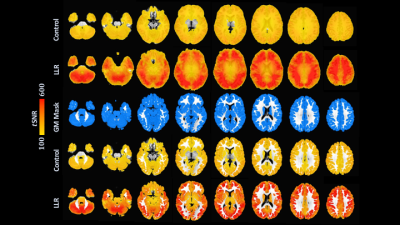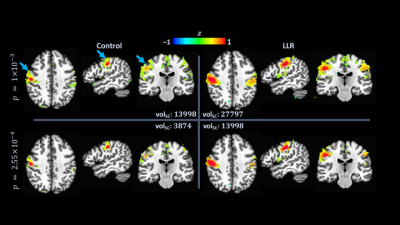Nolan K Meyer1, Daehun Kang2, MyungHo In2, John Huston2, Yunhong Shu2, Matt A Bernstein2, and Joshua D Trzasko2
1Mayo Clinic Graduate School of Biomedical Sciences, Rochester, MN, United States, 2Radiology, Mayo Clinic, Rochester, MN, United States
1Mayo Clinic Graduate School of Biomedical Sciences, Rochester, MN, United States, 2Radiology, Mayo Clinic, Rochester, MN, United States
Locally low-rank regularization methods are extended to denoise multi-echo resting-state functional MRI data, yielding substantial increases in temporal signal to noise ratio and robustly improved network connectivity mapping.

Figure 1. Group
mean atlased tSNR,
identically viewed and windowed (rows 1-2), and masked to grey matter (rows
3-5). Control images shown in rows 1/4; LLR-denoised images, rows 2/5. For
control data, global, masked, and default mode, auditory, and sensorimotor
network seed mean and standard deviation tSNRs were 180.98 ± 17.19, 181.75 ± 18.40,
132.28 ± 7.29, 236.79 ± 28.67, and 246.87 ± 41.24 respectively; for LLR data,
454.10 ± 62.76, 436.63 ± 66.58, 237.83 ± 27.87, 498.25 ± 71.02, and 576.57 ±
161.65.

Figure 5. Group-level
sensorimotor network connectivity statistical map. Left column shows control
data; right column, LLR-denoised data. Shown for each variant and threshold are
volumes (volSC) of the seed-containing cluster (blue
arrows). Clusters are thresholded in
volume to 40 voxels. Top row has maps thresholded to $$$p=1\times{10}^{-3}$$$;
bottom row, $$$p=2.55\times{10}^{-4}$$$ (reduction to $$$25.5\%$$$ of baseline) for LLR-denoised data to replicate volSC of control. LLR-denoised data show a $$$98.58\%$$$ increase in volSC at $$$p=1\times{10}^{-3}$$$.
